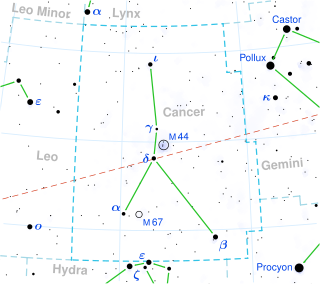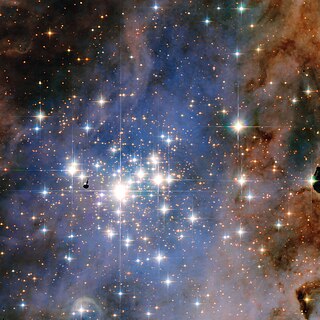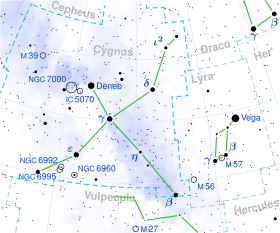79 Ceti, also known as HD 16141, is a binary star system located 123 light-years from the Sun in the southern constellation of Cetus. It has an apparent visual magnitude of +6.83, which puts it below the normal limit for visibility with the average naked eye. The star is drifting closer to the Earth with a heliocentric radial velocity of −51 km/s.

Epsilon Cancri is a white-hued binary star system in the zodiac constellation of Cancer. It is the brightest member of the Beehive Cluster with an apparent visual magnitude of +6.29, which is near the lower limit of visibility with the naked eye. The annual parallax shift of 5.3 mas as seen from Earth yields a distance estimate of approximately 616 light-years from the Sun.

HD 93129 is a triple star system in the Carina Nebula, with all three components being hot O class stars amongst the most luminous stars in the Milky Way. It is the dominant member of the Trumpler 14 star cluster, a young star cluster within the Carina OB1 stellar association that harbors other super-luminous stars, like Eta Carinae and WR 25.
Theta Pictoris is a star in the Pictor constellation.
HD 222582 is a multiple star system in the equatorial constellation of Aquarius. It is invisible to the naked eye with an apparent visual magnitude of 7.7, but can be viewed with binoculars or a small telescope. The system is located at a distance of 138 light years from the Sun based on parallax, and it is drifting further away with a radial velocity of +12 km/s. It is located close enough to the ecliptic that it is subject to lunar occultations.
HD 142415 is a single star in the southern constellation of Norma, positioned next to the southern constellation border with Triangulum Australe and less than a degree to the west of NGC 6025. With an apparent visual magnitude of 7.33, it is too faint to be visible to the naked eye. The distance to this star is 116 light years from the Sun based on parallax, but it is drifting closer with a radial velocity of −12 km/s. It is a candidate member of the NGC 1901 open cluster of stars.

HD 93250 is a highly luminous hot blue binary star in the Carina Nebula in the constellation Carina.
Cygnus OB2 #8A is a double-lined spectroscopic binary located near the centre of the Cygnus OB2 association located 5,500 light years away.
HD 145377 is a star in the southern constellation Scorpius. It has an apparent visual magnitude of 8.10 and can be viewed with a small telescope. The star is located at a distance of 175 light years from the Sun based on parallax, and it is drifting further away with a radial velocity of +11.6. The absolute magnitude of this star is 4.31, indicating it would be visible to the naked eye if it were at a distance of 10 parsecs.

V381 Cephei is a triple star system in the northern constellation of Cepheus. Its apparent magnitude is slightly variable between 5.5 and 5.7.

5 Vulpeculae is a single, white-hued star in the northern constellation of Vulpecula. It is situated amidst a random concentration of bright stars designated Collinder 399, or Brocchi's Cluster. This is a faint star that is just visible to the naked eye with an apparent visual magnitude of 5.60. Based upon an annual parallax shift of 13.8921±0.0900 mas, it is located around 235 light years from the Sun. It is moving closer with a heliocentric radial velocity of −21 km/s, and will make its closest approach in 2.5 million years at a separation of around 120 ly (36.89 pc).
HD 16754 is a binary or triple-star system in the constellation Eridanus. It has the Bayer designation s Eridani; HD 16754 is the designation from the Henry Draper catalogue. The system is visible to the naked eye as a faint point of light with an apparent visual magnitude of +4.74. It is located at a distance of approximately 132 light years from the Sun based on parallax, and is drifting further away with a radial velocity of +18 km/s. The system is a member of the Columba association of co-moving stars.

WR 24 is a Wolf-Rayet star in the constellation Carina. It is one of the most luminous stars known. At the edge of naked eye visibility it is also one of the brightest Wolf Rayet stars in the sky.
HD 106515 is a binary star in the constellation of Virgo.
ADS 9731 is a star system that consists of six stars, located in the constellation of Corona Borealis. Four of the stars are visually separate in the sky, forming a visual star system, which was resolved using adaptive optics in 1995. Two of these stars were themselves found to be spectroscopic binaries in 1998, resulting in a total of six known stars in the system. It is one of very few multiple star systems known to have at least six members.
HD 222155 is a star in the northern constellation of Andromeda. It is a yellow star that can be viewed with binoculars or a small telescope, but is too faint to be seen with the naked eye at an apparent visual magnitude of 7.1. The imaging survey in 2017 did not detected any stellar companions to HD 222155.

XX Persei is a semiregular variable red supergiant star in the constellation Perseus, between the Double Cluster and the border with Andromeda.

HD 131399 is a star system in the constellation of Centaurus. Based on the system's electromagnetic spectrum, it is located around 351 light-years away. The total apparent magnitude is 7.07, but because of interstellar dust between it and the Earth, it appears 0.22 ± 0.09 magnitudes dimmer than it should be.
HD 217786 is a binary star system in the equatorial constellation of Pisces. With an apparent visual magnitude of 7.78, it requires binoculars or a small telescope to view. The system is located at a distance of 181 light-years from the Sun based on parallax, and is drifting further away with a radial velocity of +10 km/s. Kinematically, the star system belongs to the thin disk population of the Milky Way.









